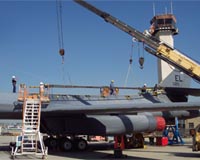| . |  |
. |
Washington (UPI) Jun 2, 2009 Wars are costly, messy things. They are never efficient and only very seldom elegant. Larger wars between major industrial powers, of course, destroy lots of weapons systems as well as lots of people. That is why major powers still need lots of soldiers and lots of relatively cheap, easily manufactured and easily replaced weapons systems. Carl von Clausewitz, the greatest theoretician of modern war, warned nearly 200 years ago that one of the most defining characteristics of war was what he called "friction." The inevitable and unavoidable chaos of war means that the more large-scale operations are meticulously planned from beginning to end, the more likely they are to go wrong. The legendary 19th century physicist Lord Kelvin recognized this same principle of order inevitably decaying into disorder as one of the basic characteristics of the universe and enshrined it in his Second Law of Thermodynamics. The mythical Irish-American philosopher Murphy put it more succinctly in Murphy's Law: "Anything that can go wrong will go wrong." When this friction or entropy principle is applied to the clash of major nations in war, the unavoidable lesson emerges that combatant nations have to be able to produce as many effective weapons systems as possible and get them to their combat armies in order to win. The United States and the Soviet Union both applied this principle with overwhelming success against Nazi Germany in World War II. In the 21st century, however, this fundamental principle of the need to mass-produce -- or retain the industrial potential to mass-produce -- as many weapons as simply as possible has been heavily eroded in the United States. The U.S. industrial base is only a fraction of the size, variety and complexity it was 40 years ago. It was first eroded by competition from Japan, and over the past quarter-century it has been devastated by hundreds of billions of dollars of imports from the People's Republic of China. Both Japan and China retained very strong protectionist barriers, primarily by drastically artificially undervaluing their currencies, while successive U.S. governments -- Republican and Democrat alike -- refused to respond with similar or symmetrical measures. This week, General Motors passed into receivership and Chrysler preceded it there. Second, the preponderance of high-tech specialist defense companies in the U.S. economy, with their concomitant influence on the political process, has led successive congresses -- once again of both parties, and of liberals and conservatives alike -- to prefer to pursue cutting-edge research and development rather than giving priority to maintaining a large, lower-tech industrial base that can mass-produce automatic weapons, light infantry vehicles and other equipment. Third, both political and military decision-makers far prefer to invest in the most expensive, ambitious, high-prestige items possible rather than the much smaller, humbler weapons systems that usually prove far more crucial in wars. These processes have applied, if anything, far more to the U.S. Air Force and Navy than to the U.S. Army and Marine Corps. But the long and exhausting counterinsurgency operations in Iraq and increasingly in Afghanistan have drained the U.S. Army and Marine Corps. During the years when Donald Rumsfeld ran the Pentagon as secretary of defense, money was poured out on every imaginable cutting-edge, high-tech visionary project. But the meat-and-potatoes needs of the U.S. armed forces were relatively overlooked as a result. Part 5: Why 21st century wars will still need large industrial facilities to supply their weapons Share This Article With Planet Earth
Related Links The latest in Military Technology for the 21st century at SpaceWar.com
 Boeing Team Rebuilds B-1 Backbone For USAF
Boeing Team Rebuilds B-1 Backbone For USAFLong Beach CA (SPX) Jun 02, 2009 A U.S. Air Force B-1B bomber returned to flight last week after a team led by Boeing replaced its catastrophically damaged upper-center boron longeron - the aircraft's "backbone." The B-1, Swift Justice, was damaged during a routine training mission in December 2007. An engine-bleed air duct rupture triggered a temperature warning light, forcing the crew to land the aircraft at Ellsworth ... read more |
|
| The content herein, unless otherwise known to be public domain, are Copyright 1995-2009 - SpaceDaily. AFP and UPI Wire Stories are copyright Agence France-Presse and United Press International. ESA Portal Reports are copyright European Space Agency. All NASA sourced material is public domain. Additional copyrights may apply in whole or part to other bona fide parties. Advertising does not imply endorsement,agreement or approval of any opinions, statements or information provided by SpaceDaily on any Web page published or hosted by SpaceDaily. Privacy Statement |